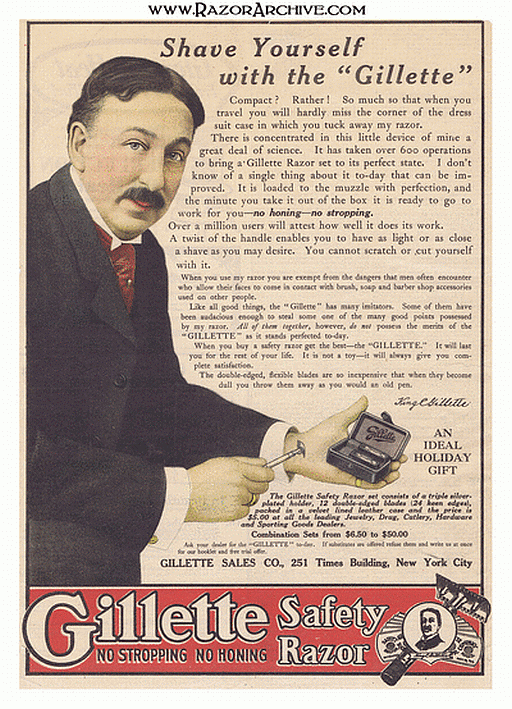We are very lucky indeed that Matt Pisarcik of Razor Emporium, an expert on the subject, has agreed to write these articles that give us some fantastic background and context when looking at traditional shaving today and our continuing use of great classic razors:
Company Origins
When most people think of the Gillette Safety Razor Company, they most likely immediately picture their safety razors of yesteryear or perhaps the modern plastic shaving systems of today. And if you thought a bit harder, you may even conjure up an image of company founder King C. Gillette’s face plastered on all early safety razor blades, boxes, instructions and so forth; or your father using one of their razors to shave with. However, it would take a while before you may come to think of them as a very leading advertising agency, which is precisely what Gillette was throughout most of their history.
Around the turn of the century, safety razors were already in existence and gaining mild popularity. Companies like Kampfe Brothers (the inventor of the Safety Razor), GEM and even J.A. Henckles of Germany were popularizing the new trend to own a shaving razor. While these shaving devices merely put a miniaturized straight razor blade upon a handle, they certainly did start the ball rolling away from the traditional cut-throat style razor popular in barber shops.
This was the market climate that a middle-aged King Gillette found himself in—where even a safety razor blade still was a life-long tool that needed upkeep and care; requiring the owner to hone and strop the blade with regular usage. An idea was born for a disposable safety razor blade utilizing thin sheet-metal sharpened on both sides; made cheap enough to throw away but good enough for several acceptable and comfortable shaves. King had his patentable invention, and along with it, a customer who would need a life time supply of these blades with the onetime purchase of his fancy handle.
This set the stage for what we now know as “Freebie Marketing”, in which the customer receives what is perceived as the product for next to nothing in cost, yet has to upkeep or furnish this device with replacement parts that actually are the revenue-driving component of the business model. Other examples include computer printers and ink/toner, automobile parts and even gaming consoles and software.
1900’s
Another common method of marketing that Gillette used pervasively and came to perfect was Printed Advertisement. In these high-quality scans from Razor Archive, one can clearly see the early push that Gillette employed to get men to stop using straight razors or visiting barbershops all together. They constantly talked about the hassle of upkeep on a traditional straight razor, saving time and of course “No Honing, No Stropping” that they even incorporated into their logo. Gillette even ran attack ads against barbershops; spreading fear of infections and disease that can be spread by visiting one, and that all together they were dirty and unclean places.
Not only was there a product to be sold in these adverts, but more importantly a message and a promise from King himself—urging the public to try his razor for a 30 day trial or guaranteeing it will be more comfortable than other methods of shaving. Again, such common advertisement techniques that we know of today were not so common in an era where manufacturing companies rarely interfaced so directly with their target market of consumers and instead relied heavily on retail stores to drive sales.
to be continued……




Permalink
good for 20-40 shaves according to the adds – that is interesting. I change the blade weekly whether it needs it or not. Shaving could be even cheaper!! 🙂 But I must admit I, probably like most of us, like to try different blades and so on. So weekly gives me more variety.
Permalink
Wow. Great article. It’s interesting to see how in the 1900’s the trend shifted away from straight razor shaving to safety razors. Today, it seems as if many men are going back to the classic form of shaving.
Can’t wait for the next part of this article
Permalink
Great article. Could you mail me with the link to part two when it is done?
Found this as I heard Gilette also convinced people that having a beard or facial hair was dirty or unclean. Really interesting